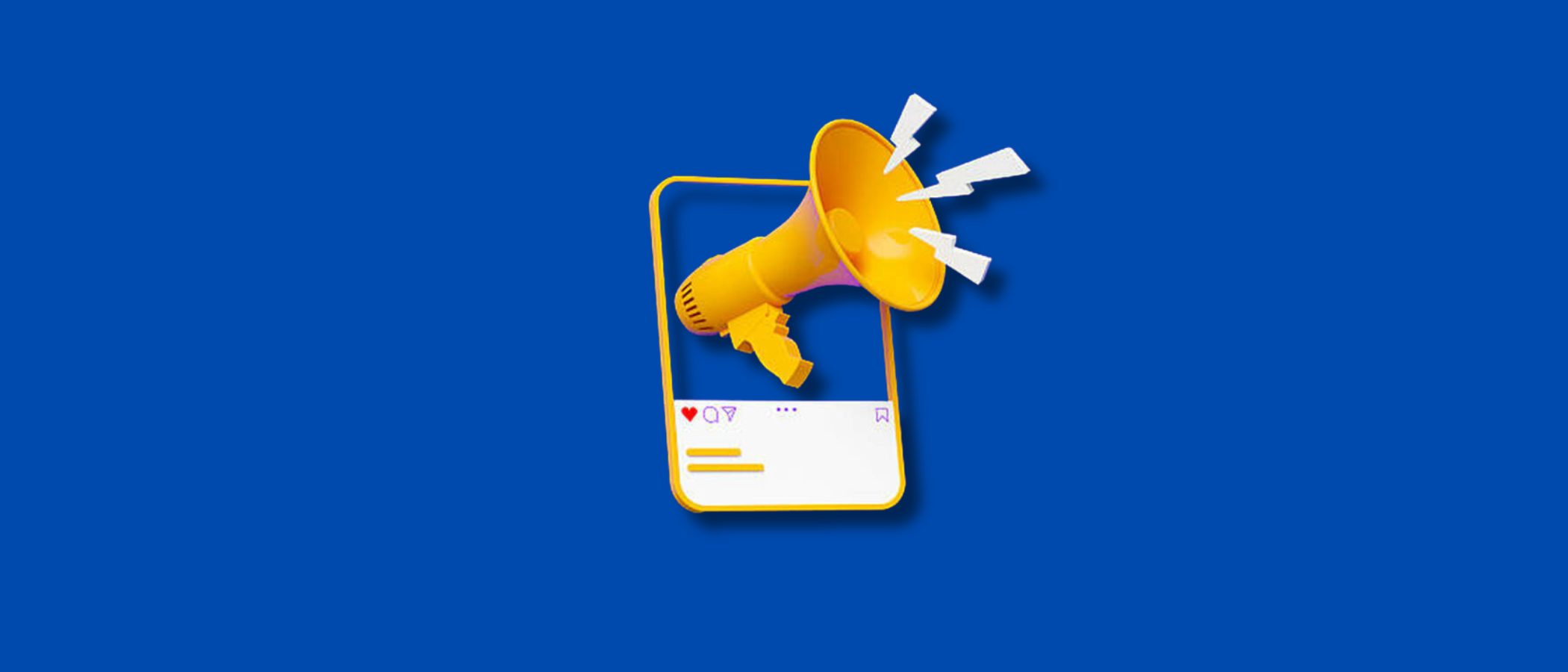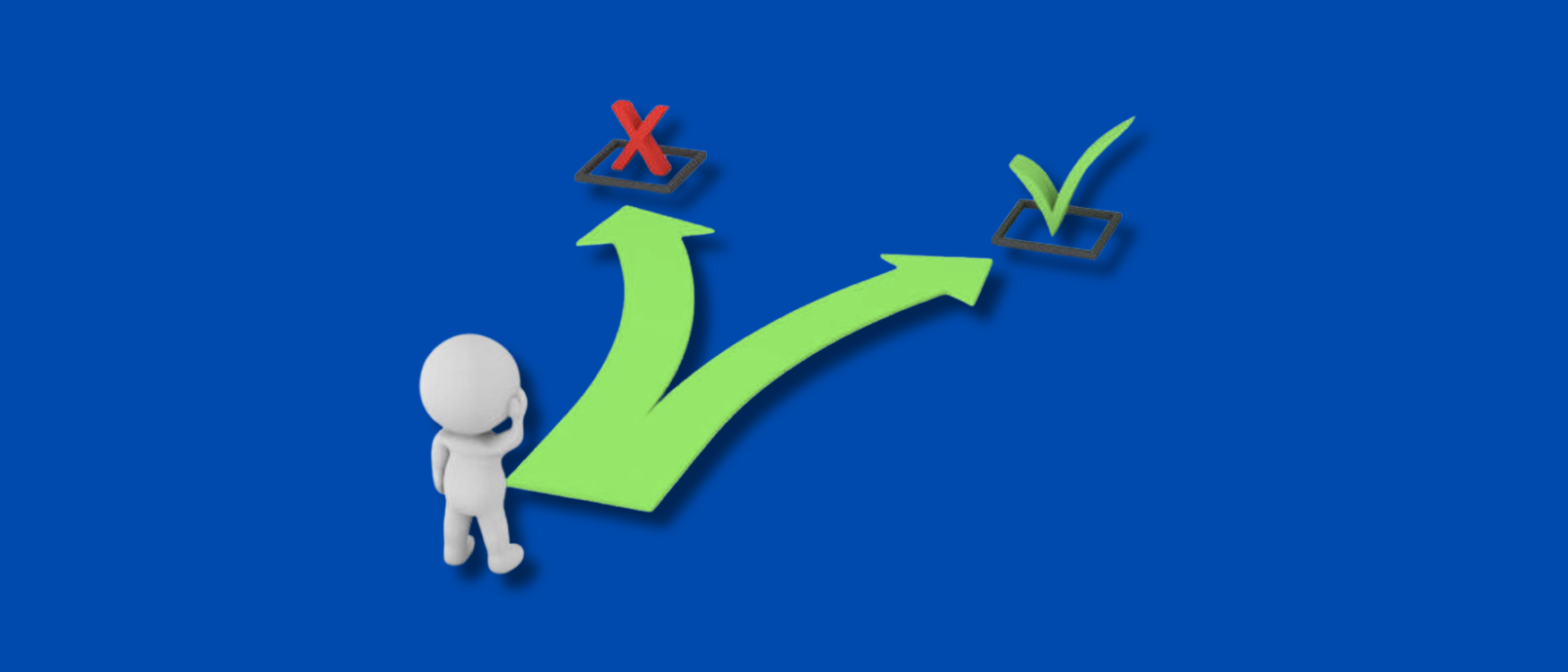Introduction
The healthcare industry is undergoing a digital revolution, with mobile health (mHealth) apps emerging as powerful tools reshaping patient care and medical workflows. Fueling this transformation are some compelling stats:
- The global mHealth market generated 63,989.4 million in 2023 and is projected to reach 162,284.2 million by 2030, with North America currently dominating adoption.
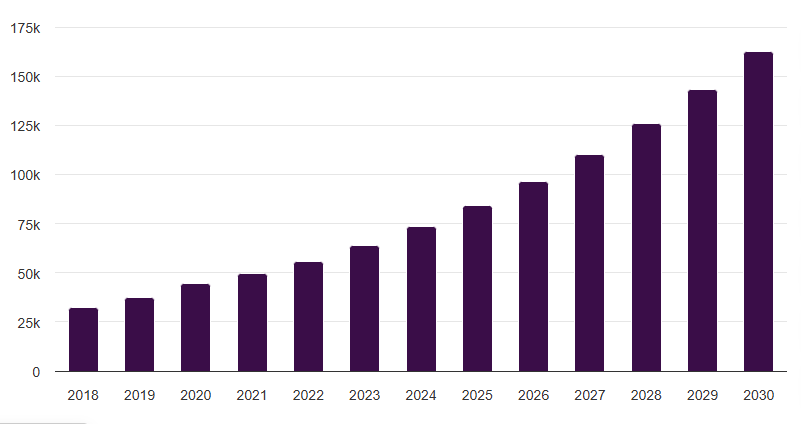
- These healthcare applications are transforming care delivery: Doctors and hospital staff now use them to:
- Access EHRs and patient histories in real-time,
- Coordinate care through secure messaging,
- Reference drug databases and treatment protocols, and
- Streamline appointment scheduling and reminders.
For health app development startups, this explosive growth creates immense opportunities.
Whether you’re exploring mental health app ideas to support wellbeing or building AI-powered medical diagnosis apps for early disease detection, innovative healthcare mobile applications can bridge critical gaps in care while driving profitability.
From custom health app development for niche needs to scalable digital health solutions, the market is ripe for disruption.
In this guide, we’ll reveal the top 20 groundbreaking healthcare app ideas for 2025 – complete with key features, monetization strategies, and technical considerations to help you launch a successful healthcare startup.
Major Types of Healthcare Apps
Before exploring the top healthcare app ideas, let’s categorize them by target users. Understanding these segments ensures your app solves real needs and reaches the right audience.
- Apps for Medical Professionals
Built for doctors, nurses, and researchers, these apps enhance clinical workflows and decision-making. Examples include:
- Telehealth platforms (e.g., Zoom for Healthcare)
- Remote patient monitoring apps (e.g., Apple Watch’s FDA-cleared AFib detection for clinical trials)
- Medical reference tools (e.g., Epocrates for drug interactions)
Real-world impact: A 2023 study found a smartphone app detected Frontotemporal Dementia with 89% accuracy in 360 participants, proving apps can augment diagnostics.
- Apps for Patients & Families
Designed to empower users in self-care and emergency response:
- Symptom checkers (e.g., Ada Health)
- Baby monitors (e.g., FDA-cleared Masimo Stork app with pulse oximetry)
- Mental wellness apps (e.g., Headspace for anxiety relief)
Why it matters: The Masimo Stork app, used by top U.S. hospitals, helps parents track infants’ oxygen levels—a lifesaving feature for newborns.
- Apps for Hospitals & Clinics
Streamline operations for healthcare providers:
- EHR/EMR systems (e.g., Epic MyChart)
- Inventory managers (e.g., Sortly for medical supplies)
- Clinical decision support (e.g., VisualDx for diagnostic accuracy)
Read Also: 8 Best Medical Diagnosis Apps for Patients and Doctors in 2025
20 Best Healthcare App Ideas For 2025
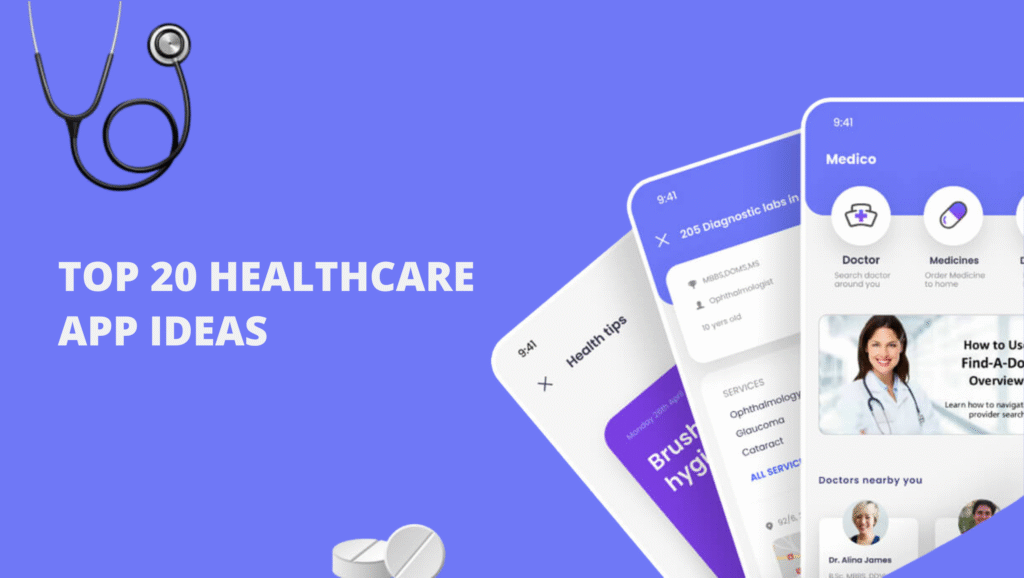
The revolution of healthcare application development is rapidly accelerating, with the global digital health market estimated to exceed. $300 billion by the year 2025.
With the ubiquity of smartphones, the transformational power of artificial intelligence on diagnostics, and the increasing ubiquity of healthcare mobile applications, digital health mobile applications have shifted to necessary tools that close gaps between patients, doctors, and medical systems.
For startups and entrepreneurs, this explosion in healthcare technology presents once-in-a-lifetime opportunities.
Whether you’re exploring mental health app ideas to combat rising anxiety rates or building AI-powered medical diagnosis apps for early disease detection, the right concept can save lives while scaling fast.
In this list, we’ve curated the 20 most innovative healthcare app ideas poised to dominate in 2025, covering:
- Patient-centric solutions (telemedicine, chronic care, elderly assistance)
- Clinical tools (EHR integrations, AR surgery assistants)
- Preventive health tech (AI nutrition coaches, genetic risk predictors)
- Operational disruptors (hospital inventory bots, blockchain health records)
Each idea includes real-world examples, market data, and key features to help you validate demand and prioritize development.
Let’s build the future of healthcare applications—one breakthrough app at a time.
- Mental Health Apps

Mental health apps offer immediate, professional care to users (or their caregivers) dealing with adverse mental health situations.
These healthcare apps come with text, audio, and video chat options, allowing users to confidentially connect with a licensed therapist or psychiatrist for assessment and follow-up care.
Types of Mental Health Apps
- Virtual Therapy Apps – Live sessions with certified professionals (Talkspace, BetterHelp)
- Self-Management Tools – Mood tracking/CBT exercises (Sanvello, Woebot)
- Crisis Intervention Apps – Emergency hotlines/panic relief (Crisis Text Line)
- Corporate Wellness Apps – Employer-sponsored mental health programs (Headspace for Work)
Top Examples
| App Name | Platform | Key Feature | Compliance |
| Calm | iOS/Android | Sleep/meditation content | HIPAA-compliant premium therapy |
| Headspace | iOS/Android | Mindfulness for anxiety | FDA-cleared “Sleep Health” feature |
| Talkspace | iOS/Android | Unlimited messaging therapy | Partnered with 1 M+ employers |
Critical Compliance Note:
Before developing a mental health app, ensure adherence to:
- HIPAA (US patient data protection)
- GDPR (EU privacy laws)
- FDA clearance for diagnostic features
(Example: Replika AI chatbot was banned in Italy for violating GDPR)
Why This Matters in 2025:
- 89% of users prefer apps over in-person therapy for stigma reduction
- Mental health app development costs 60% less than clinical infrastructure
- The global teletherapy market will reach $19.5B by 2027 (Statista)
- Women Healthcare Apps
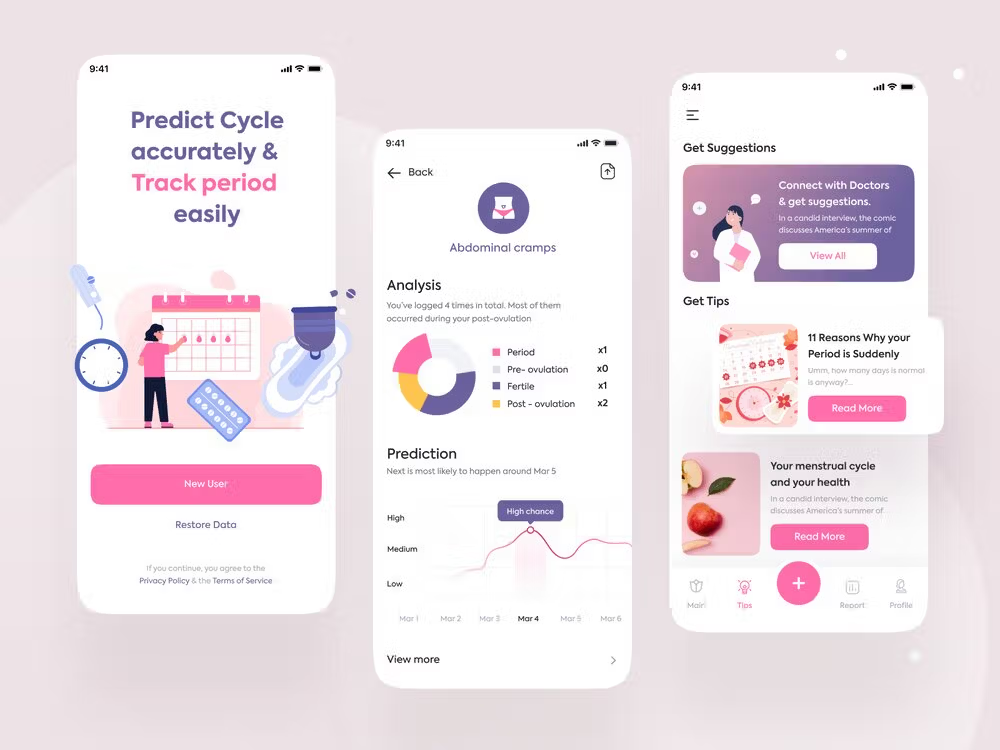
A women’s healthcare application offers specialized medical support for all female-specific health needs, from reproductive care to chronic illnesses.
These digital health applications include several features: symptom checkers, telehealth gynecology appointments, and personalized health tracking—all to help women secure and manage their summary of health.
Types of Women’s Healthcare Apps
- Reproductive Health Trackers – Period/fertility monitoring (Clue, Flo)
- Pregnancy & Postpartum Apps – Prenatal care/baby development guides (Ovia, The Bump)
- Breast Cancer Screening Tools – AI-powered risk assessments (Niramai, iBreastCheck)
- Menopause Management Apps – Symptom relief/hormone tracking (Menopause Monitor, Stella)
Top Examples
| App Name | Platform | Key Feature | Compliance |
| Flo | iOS/Android | AI period/ovulation predictions | GDPR-compliant |
| Maven Clinic | iOS/Android | Virtual OB-GYN visits | HIPAA-certified |
| Kegg | iOS/Android | Cervical mucus fertility tracker | FDA-cleared device sync |
Critical Compliance Note:
Before developing a women’s healthcare app, ensure:
- HIPAA compliance for US patient data (e.g., pregnancy records)
- CE Marking for EU medical device regulations (Example: Ada Health’s diagnosis app required CE certification)
- FDA approval for diagnostic features (e.g., mammogram analysis AI)
Why This Matters in 2025:
- 72% of women prefer apps over clinic visits for sensitive health issues (Rock Health)
- The femtech market will reach $60B by 2027, with apps driving 40% of growth
- Free medical diagnosis apps like Ada see 3M+ monthly downloads (low-cost user acquisition)
- Doctors-On-Demand Apps

A Doctors-On-Demand app connects patients to licensed physicians instantly via video, chat, or voice calls, changing the way you receive healthcare.
These healthcare app ideas are especially beneficial in countries like Bangladesh, as health app development fills significant gaps in the health system.
Types of Doctors-On-Demand Apps
- General Consultations – Connect with GPs for common illnesses (e.g., Tonic in Bangladesh)
- Specialist Access – Dermatologists, pediatricians, etc. (e.g., Doctor On Demand)
- AI Triage + Diagnosis – Medical diagnosis app tools with doctor referrals (e.g., Ada Health)
- Emergency Services – Instant response for urgent cases (e.g., Alodokter)
Top Examples
| App Name | Platform | Key Feature | Compliance |
| Tonic | iOS/Android | Best healthcare app in Bangladesh with local doctors | HIPAA-like encryption |
| Ada | iOS/Android | Free medical diagnosis app + paid doctor consults | GDPR/CE Mark |
| DocTime | iOS/Android | Bengali/English multilingual support | BD Medical Council approved |
Critical Compliance Note:
Before launching, ensure:
- HIPAA/GDPR for patient data (if global)
- Local medical regulations (e.g., Bangladesh Medical Council)
- FDA/CE clearance for AI diagnosis features
Why Invest in 2025?
- Health app development costs dropped 40% with cloud telehealth APIs
- Medical diagnosis app android users grew 200% in South Asia (2023)
- Free medical diagnosis app models attract 5x more users (freemium upsell)
- Self-Test Apps
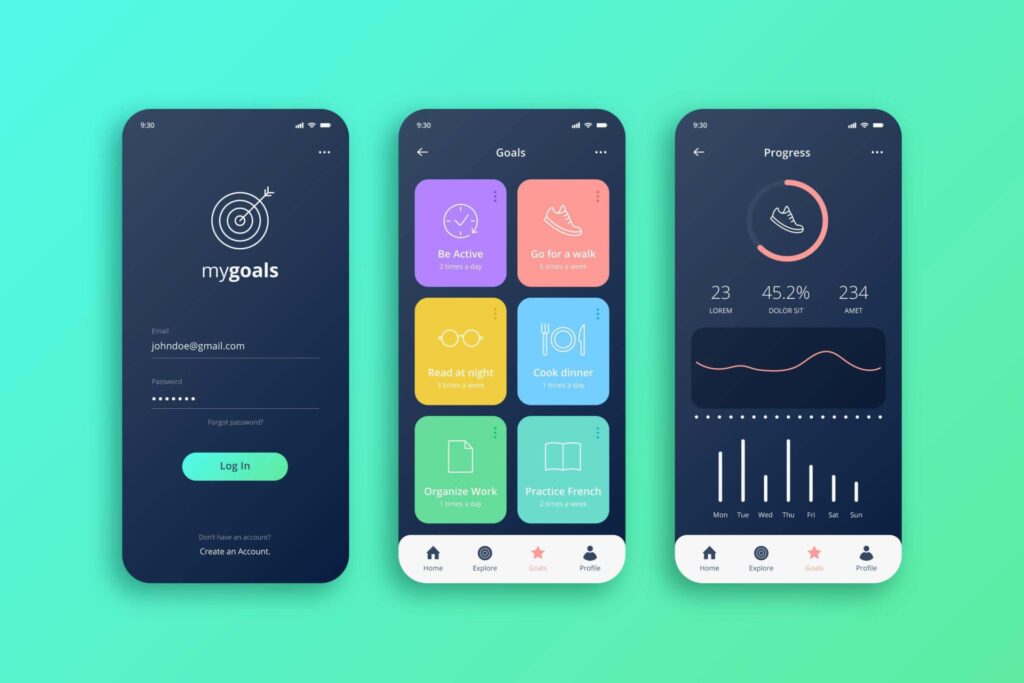
The rise of healthcare app ideas like self-test tools empowers people to monitor their health anytime, anywhere.
These medical diagnosis app solutions range from symptom checkers to at-home test integrations, giving users control while reducing clinic overcrowding.
Why Self-Test Apps Matter in 2025
- 60% of patients prefer free medical diagnosis app options before visiting doctors (Rock Health 2024)
- Medical diagnosis app android & iOS tools can detect early signs of diabetes, UTIs, or even COVID-19
- Startups partnering with a health app development company see 50% faster FDA/CE approvals
Top Self-Test App Categories
| Type | How It Works | Example Apps |
| AI Symptom Checkers | Chatbot asks questions, suggests conditions | Ada, Symptomate |
| At-Home Test Sync | Scan lab strips (urine/blood) with your phone | Scanwell, Healthy.io |
| Voice-Based Diagnostics | Cough/speech analysis for respiratory issues | ResApp, Sonde Health |
| Mental Health Screeners | 5-minute quizzes for anxiety/depression | MindDoc, Depression CBT |
Key Features to Include
- Instant Results – Clear explanations without medical jargon
- Lab/Device Integration – Sync with glucose meters, BP monitors
- Emergency Alerts – Flags critical symptoms (e.g., heart attack signs)
- Multi-Language Support – Critical for global apps
Success Story: Healthy.io turned smartphone cameras into UTI test readers—now used in 12 countries with 90% accuracy.
Compliance Checklist
- FDA/CE Mark for diagnosis claims (Class I/II devices)
- GDPR/HIPAA for data privacy if storing health records
- Clinical Validation – Partner with hospitals for credibility
Pro Tip: Start with a free medical diagnosis app model to build trust, then offer premium lab/test partnerships.
For Developers:
- Use open-source SDKs like TensorFlow Lite for a medical diagnosis app and Android AI models.
- Prioritize offline mode for areas with poor internet
“The best healthcare app isn’t just accurate—it makes users feel heard and guided.”
Ready to explore how a health app development company can bring your idea to life? Or move to the next innovation?
- Medical Store Apps
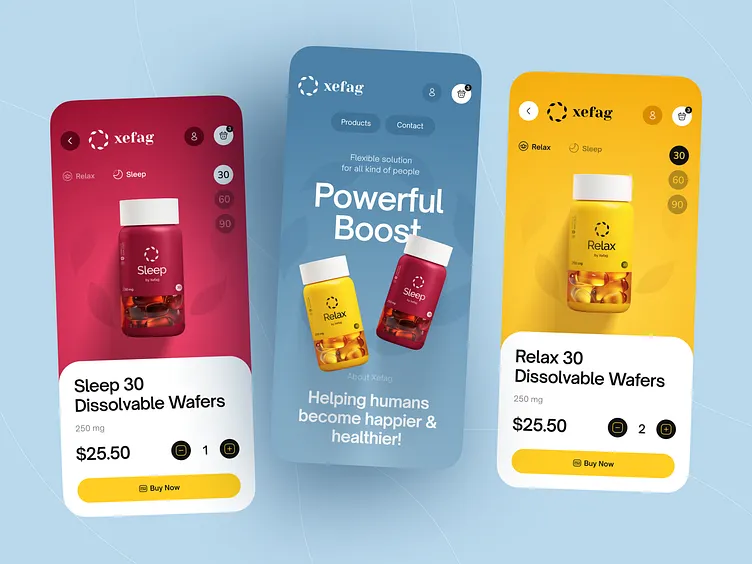
The right healthcare app ideas can bridge the gap between patients and pharmacies, and medical store apps do exactly that.
These health app development solutions empower users to order medicines, compare prices, check availability, and even consult pharmacists—all from their smartphones.
Why Medical Store Apps Are Booming in 2025
- 70% of users prefer ordering meds via apps over visiting physical stores (Statista 2024)
- Best healthcare app examples in emerging markets show 3x faster delivery than traditional pharmacies
- Integration with medical diagnosis app tools allows automatic prescription uploads
Types of Medical Store Apps
| Type | Key Features | Top Examples | Market Impact |
| Medication Delivery | Prescription upload, auto-refills, same-day delivery | PharmEasy, 1mg | Saves 45+ minutes per user monthly |
| Price Comparison | Scan barcodes to compare drug prices across stores | GoodRx, Medisave | Users save 30% + on generics |
| Telepharmacy | Video consultations with pharmacists for OTC advice | NowRx, Capsule | Reduces clinic visits by 25% |
| Chronic Care | Syncs with glucose/BP monitors for auto-reorders | PillPack, MyMeds | Improves adherence by 50% |
Must-Have Features for 2025
✔ AI-Powered Prescription Scanner – Extract dosage/refill data from doctor notes
✔ Geo-Targeted Alerts – Notify users when meds are available nearby
✔ Subscription Plans – Auto-deliver chronic meds monthly
✔ Chatbot Support – 24/7 answers to drug interaction questions
Success Story: PharmEasy (India’s top health app development case study) grew 400% by:
- Partnering with 5,000+ pharmacies for last-mile delivery
- Adding free medical diagnosis app features for cold/flu
Compliance & Development Tips
- HIPAA/GDPR for prescription data (if storing health records)
- FDA/CE approval is required for apps suggesting drug alternatives
- Local Regulations – E.g., Bangladesh’s DGDA rules for e-pharmacy licenses
For Startups:
“Partner with a health app development company experienced in pharmacy APIs like Surescripts (US) to speed up integrations.”
Why This Works in Emerging Markets?
- Medical diagnosis app android users often need follow-up meds—seamless linking boosts retention.
- Best healthcare app contenders in Southeast Asia see 2x more orders when offering discounts for first-time users.
- Sleeping Apps
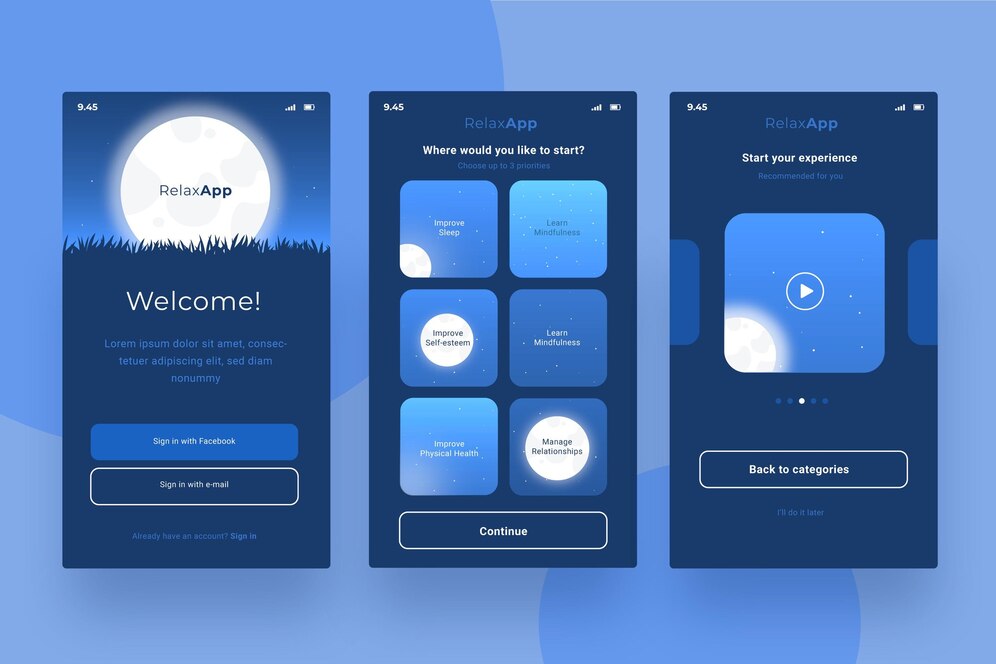
Poor sleep affects 1 in 3 adults globally.
Sleeping apps help users fall asleep faster, stay asleep longer, and wake up refreshed through science-backed solutions, making them one of the most impactful healthcare app ideas today.
Why Sleep Apps Are Trending in 2025
- The sleep tech market will hit $32 billion by 2026 (Global Market Insights)
- 60% of users report better sleep quality within 2 weeks of app use (Sleep Foundation)
- Integration with wearables (Apple Watch, Fitbit) boosts accuracy by 40%
Types of Sleep Apps
| Type | How It Works | Top Examples | Key Benefit |
| Smart Alarm | Wakes you during light sleep phases | Sleep Cycle, Alarmy | Reduces grogginess by 70% |
| White Noise | Plays calming sounds/meditation | Calm, Noisli | Helps 80% of users fall asleep faster |
| Sleep Tracking | Syncs with wearables to analyze cycles | Pillow, SleepScore | Identifies sleep disorders early |
| Cognitive Therapy | CBT-I exercises for insomnia | Sleepio, Somryst | FDA-approved for chronic insomnia |
Must-Have Features for 2025
- Personalized Sleep Reports – AI-driven insights from wearables
- Wind-Down Routines – Custom pre-bed meditation/yoga
- Snoring Detection – Alerts for potential sleep apnea
- Smart Home Integration – Auto-adjusts lights/thermostat
Success Story: Sleep Cycle grew to 15 M+ users by:
- Adding sleep aid marketplace (earned 30% revenue boost)
- Partnering with Whoop and Oura for cross-device sync
Development & Compliance Tips
- FDA Clearance Required for:
- Insomnia treatment apps (Class II device)
- Sleep apnea detection (if claiming medical accuracy)
- Data Privacy – GDPR compliance for EU users’ sleep logs
- Monetization – Freemium model works best (5−5−15/month premium)
Pro Tip:
“Add a ‘Sleep Bank’ feature showing users their debt/credit—this boosts engagement by 25%.” – Sleep Tech Developer Survey
- Emergency Assistance Apps
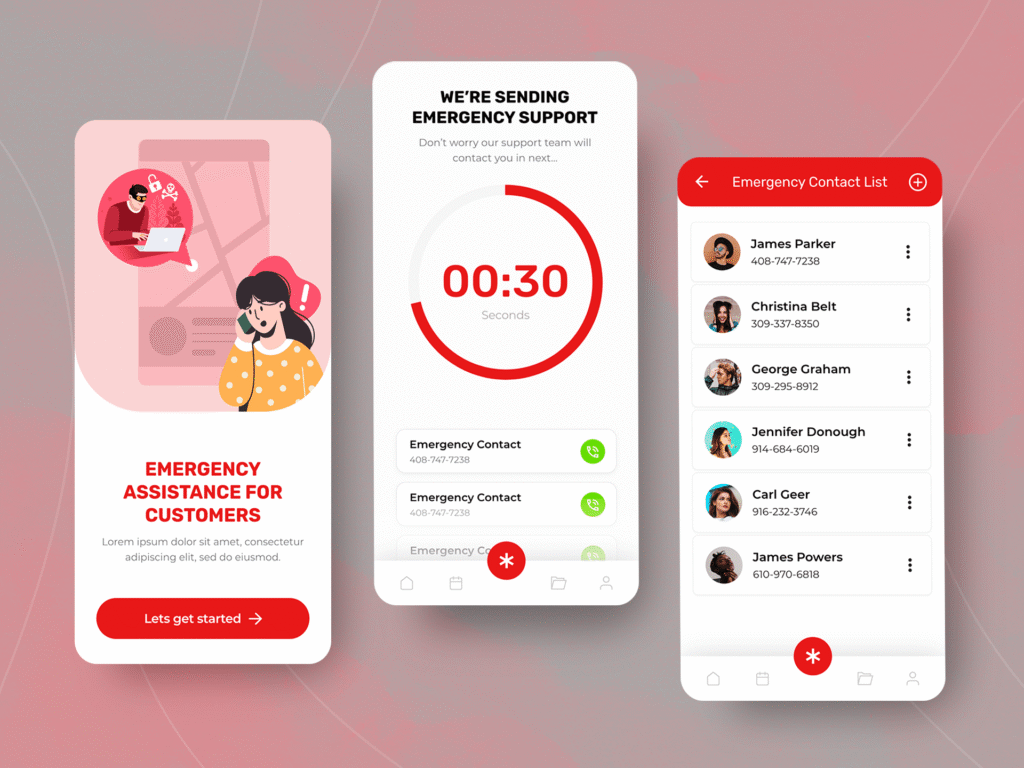
When seconds count, emergency assistance apps provide instant access to critical care, making them some of the most vital healthcare app ideas today.
These apps connect users with first responders, provide step-by-step CPR guides, and even alert nearby Good Samaritans during crises.
Why Emergency Apps Are Essential in 2025
- 10 M+ cardiac arrests occur annually worldwide (American Heart Association)
- Apps reduce emergency response times by up to 40% in urban areas
- Integration with medical diagnosis app tools helps dispatchers prioritize cases
Types of Emergency Assistance Apps
| Type | Key Features | Top Examples | Impact |
| Emergency Dispatch | One-tap 911/SOS with location sharing | RapidSOS, Noonlight | Saves 2-4 minutes in response time |
| First Aid Guides | AR-powered wound care/CPR instructions | First Aid by Red Cross, St John Ambulance | Boosts survival rates by 30% |
| Crowdsourced Rescue | Alerts trained volunteers nearby | GoodSAM, PulsePoint | 5x faster response in rural areas |
| Chronic Condition Alerts | Auto-calls EMS during seizures/low glucose | Smart911, My SOS Family | Prevents 60% of complication deaths |
Must-Have Features for 2025
- Offline Functionality – Works without signal (stores last GPS coordinates)
- Multilingual Support – Critical for tourist-heavy areas
- Wearable Integration – Auto-triggers alerts from fall/heart rate data
- Two-Way Video – Let’s dispatchers assess situations visually
Success Story: RapidSOS became the best healthcare app for emergencies by:
- Partnering with 90% of US 911 centers
- Reducing average dispatch time to under 10 seconds
Development & Compliance Checklist
- HIPAA Compliance – For transmitting medical data to responders
- Local EMS Partnerships – Required for direct 911 integration
- Battery Optimization – Must run in the background without draining
- Accessibility – Voice commands for users with mobility issues
Pro Tip:
“Add a ‘I’m Safe’ feature—40% of false alarms occur when users accidentally trigger SOS.” – Emergency Tech Developer Report
- Record-Keeping Apps
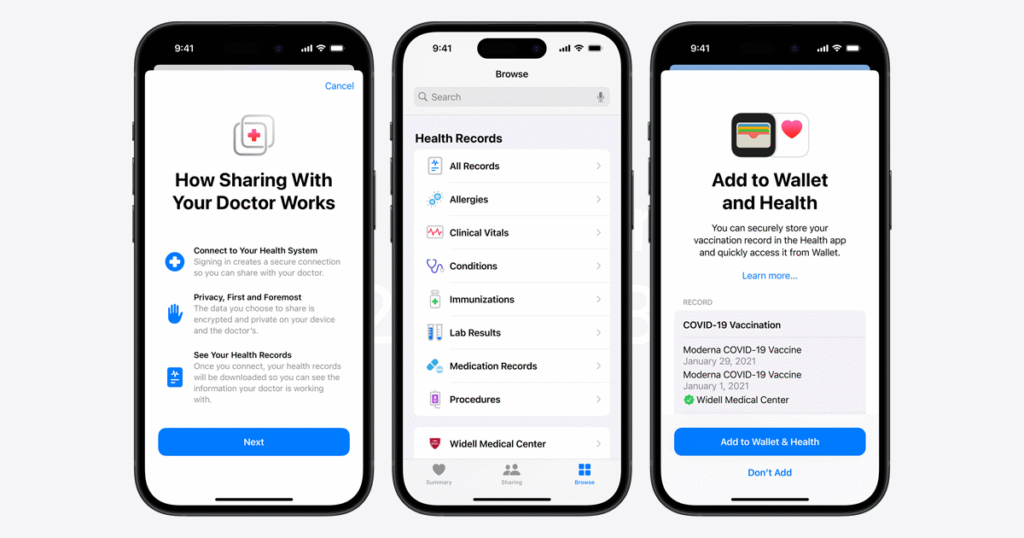
In an era where 60% of medical errors stem from poor record-keeping (WHO), these healthcare app ideas are transforming how patients and doctors manage health data.
A well-designed record-keeping app acts as a secure, centralized hub for medical history, from childhood vaccines to recent lab results.
Why Record-Keeping Apps Are Crucial in 2025
- 1 in 5 patients can’t access critical records during emergencies (Journal of Medical Systems)
- Hospitals using patient-owned health records see 30% fewer duplicate tests
- Integration with medical diagnosis app tools enables AI-powered health trend analysis
Types of Record-Keeping Apps
| Type | Key Features | Top Examples | Unique Advantage |
| Personal Health Records (PHR) | Patient-controlled EHR storage | Apple Health Records, MyChart | Syncs with 500+ hospital systems |
| Family Health Managers | Track vaccinations/meds for all family members | CareZone, HealthLocker | Shared access for caregivers |
| Travel Health Vaults | Stores international vaccine records | MyIR, CommonHealth | WHO-compliant for global travel |
| Chronic Condition Trackers | Organizes dialysis/chemo logs | MyHealthTeams, Trellis | FDA-cleared for clinical use |
Must-Have Features for 2025
- Blockchain Security – Tamper-proof audit trails for sensitive data
- AI Summarization – Turns complex records into layman’s terms
- Emergency Mode – One-tap access to allergies/meds (works offline)
- Insurance Integrations – Auto-fills claim forms with stored data
Success Story: Apple Health Records became the best healthcare app for PHRs by:
- Standardizing data across 10,000+ institutions via FHIR API
- Reducing record retrieval time from days to seconds
Development & Compliance Essentials
- HIPAA/GDPR – Required for all health data storage
- FHIR/HL7 Standards – Ensures hospital EHR compatibility
- Two-Factor Authentication – Minimum security requirement
- Blockchain Notarization – Emerging standard for legal validity
Pro Tip:
“Add a ‘Time Machine’ feature—visualizing health metrics over years boosts user engagement by 45%.” – Digital Health Report 2024
- Diet Tracking and Planning Apps
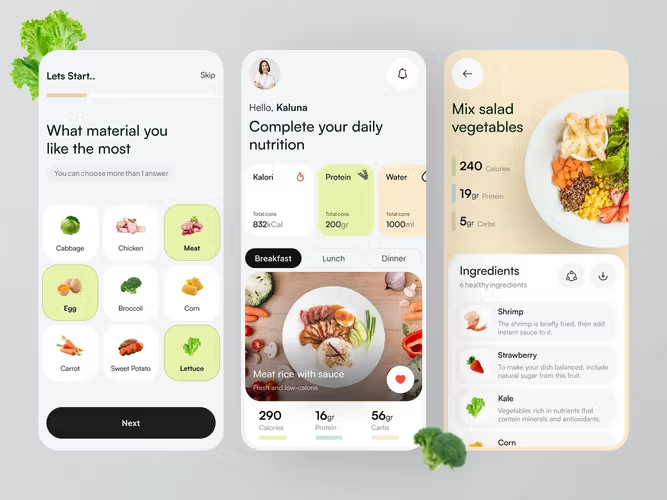
Food is medicine, and diet tracking apps are the prescription for healthier eating habits.
These healthcare app ideas combine AI-powered nutrition analysis with behavioral science to help users manage weight, control chronic conditions, and optimize wellness through smarter food choices.
Why Diet Apps Are Thriving in 2025
- 77% of users stick to diets longer with app support (Journal of Nutrition)
- The global nutrition app market will reach $4.89B by 2027 (Statista)
- Integration with continuous glucose monitors takes personalized nutrition to new levels
Types of Diet Tracking Apps
| Type | Key Features | Top Examples | Unique Value |
| Macro Trackers | AI meal logging via photos | MyFitnessPal, LoseIt! | 11M+ food database |
| Medical Diet Managers | Custom plans for diabetes/IBD | Carb Manager, Fig | Doctor-approved protocols |
| Cultural Nutrition | Halal/Kosher/regional diet filters | MyHalalRecipes, Yummly | Respects dietary customs |
| Grocery Assistants | Scan barcodes for allergen alerts | Fooducate, ShopWell | Saves $600+/year on wasted food |
Must-Have Features for 2025
- AI Photo Recognition – Instant calorie/nutrient estimates from food pic
- Health Device Sync – Pulls data from glucose monitors/scales
- Meal Planning AI – Generates grocery lists based on dietary goals
- Community Challenges – Team-based weight loss competitions
Success Story: MyFitnessPal achieved 200M+ downloads by:
- Partnering with Fitbit and Apple Health
- Adding restaurant menu integrations (30K+ venues)
Development & Compliance Tips
- FDA Considerations – Required if making medical claims (e.g., “reverses diabetes”)
- Nutrition Database Licensing – Need accurate calorie/nutrient data
- Behavioral Psychology – Gamification boosts retention by 40%
Pro Tip:
“Users who log meals before eating (not after) make 25% healthier choices—build this into your UX flow.” – Nutrition Tech Report
For Health App Development Companies:
- Use TensorFlow Lite for on-device food recognition
- Partner with registered dietitians for credibility
- Implement dark patterns ethically (e.g., healthy choice nudges)
Ready to Build?
- Need API recommendations for food databases?
- Want monetization strategies (e.g., premium meal plans)?
- See how this complements medical diagnosis app systems?
This approach serves both health goals and business success!
- Doctor’s Training Apps
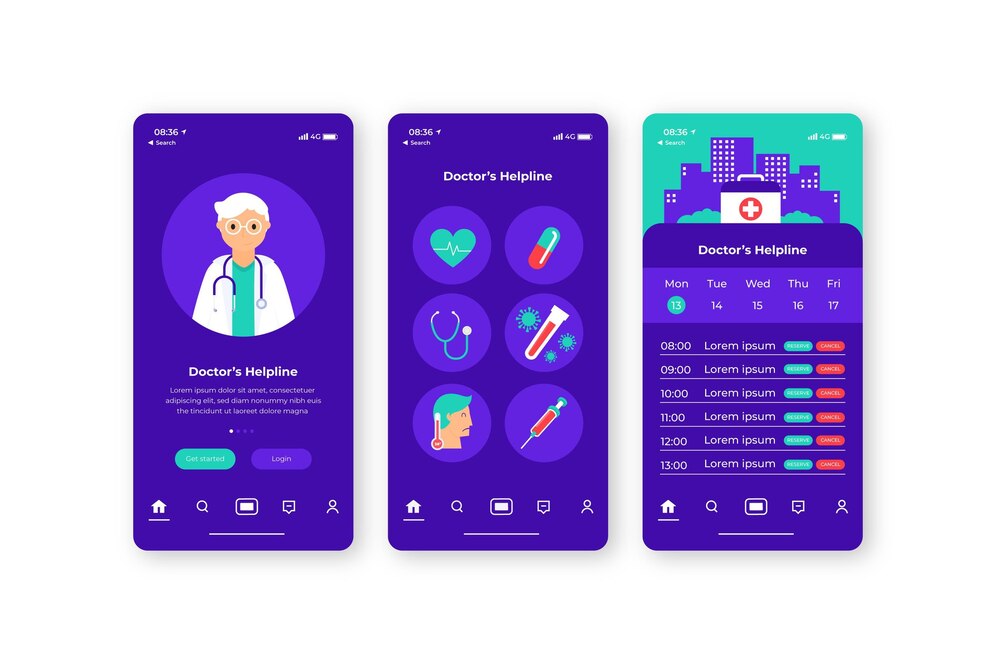
If you’re someone looking for healthcare app ideas that bridge the gap between medical theory and real-world practice, doctors’ training apps offer groundbreaking solutions.
These health app development innovations are transforming how physicians, surgeons, and medical students enhance their skills, from AR-powered anatomy lessons to AI-driven diagnosis simulations.
Why Doctor’s Training Apps Are Essential in 2025
- 70% of surgical residents use apps to prep for operations (JAMA Study)
- Hospitals with VR training see 40% fewer medical errors
- The global market for medical training apps will hit $8.9B by 2027
Types of Doctor’s Training Apps
| Type | Key Features | Top Examples | Impact |
| AR Anatomy Guides | 3D organ models with layer-by-layer exploration | Complete Anatomy, HoloAnatomy | Boosts retention by 300% |
| Surgical Simulators | Haptic feedback for virtual procedures | Osso VR, Touch Surgery | Cuts learning curves by 50% |
| AI Diagnosis Trainers | Tests diagnostic skills with real patient cases | DiagnosUs, Figure1 | Improves accuracy by 35% |
| Clinical Decision Support | Updates on the latest treatment protocols | UpToDate, DynaMed | Used by 90% of teaching hospitals |
Must-Have Features for 2025
- Haptic Feedback – Realistic touch sensations for surgical training
- Multiplayer Mode – Collaborative diagnosis sessions
- CME Integration – Tracks continuing education credits
- Patient Avatar Library – Diverse body types/conditions
Success Story: Osso VR became the best healthcare app for surgical training by:
- Partnering with Johnson & Johnson
- Reducing procedural errors by 76% in clinical trials
Development & Compliance Considerations
- FDA Clearance – Required for apps making clinical competency claims
- HIPAA Compliance – If using real patient case studies
- Cross-Platform Support – iOS/Android/VR headset compatibility
Pro Tip:
“Add ‘Mistake Analytics’—showing users exactly where they went wrong improves learning speed by 2x.” – Medical Education Tech Report
For Health App Development Companies:
- Use Unity 3D for realistic simulations
- Partner with teaching hospitals for validation studies
- Implement adaptive learning algorithms
- Reminder Apps
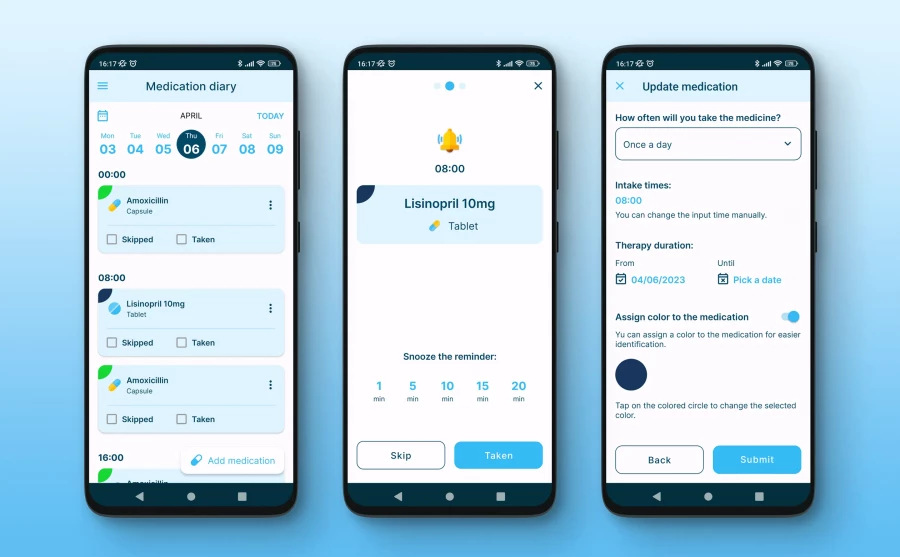
For patients, caregivers, and busy professionals, reminder apps are the invisible guardians of consistent care.
These healthcare app ideas do more than alert users—they adapt to routines, predict forgetfulness, and even connect to smart pill dispensers.
Why Reminder Apps Are Lifesavers in 2025
- 50% of patients don’t take medications as prescribed (WHO)
- Proper adherence could prevent 125,000 deaths annually in the US alone
- The global medication management market will reach $4.7B by 2027 (Grand View Research)
Types of Health Reminder Apps
| Type | Key Features | Top Examples | Unique Innovation |
| Basic Medication Alarms | Custom schedules with snooze options | Medisafe, MyTherapy | 85% user retention rate |
| AI-Powered Predictors | Learns patterns to pre-empt forgetfulness | Round Health, Mango Health | Reduces missed doses by 60% |
| Caregiver Connect | Shared tracking for the elderly/children | CareZone, PillPack | Real-time adherence reports |
| Smart Device Sync | Links to Bluetooth pillboxes/glucometers | Hero, Pillo | Auto-dispenses correct doses |
Must-Have Features for 2025
- Context-Aware Alerts – Adjusts reminders based on location (e.g., “Take meds now that you’re home”)
- Emergency Overrides – Auto-contacts caregiver after 3 missed doses
- Pharmacy Integration – Auto-requests refills when supplies run low
- Voice-Activated Logging – “Alexa, I took my metformin”
Success Story: Medisafe achieved 10M+ users by:
- Adding pharmacy coupon integration (saved users $250/year)
- Developing AI that detects “habit drift” 2 days before misses occur
Development & Compliance Essentials
- HIPAA Compliance – Critical for apps storing medication histories
- FDA Considerations – Required if paired with smart dispensers
- Behavioral Science – Gamification boosts adherence by 40%
Pro Tip:
“Users ignore 70% of standard alerts—but personalized messages (e.g., ‘Your BP med prevents strokes, Mom’) see 90%+ response rates.” – Adherence Tech Study
For Health App Development Companies:
- Use geofencing APIs for location-aware alerts
- Partner with pharmacy chains for refill automation
- Implement family plan subscriptions
- Virtual Reality Apps
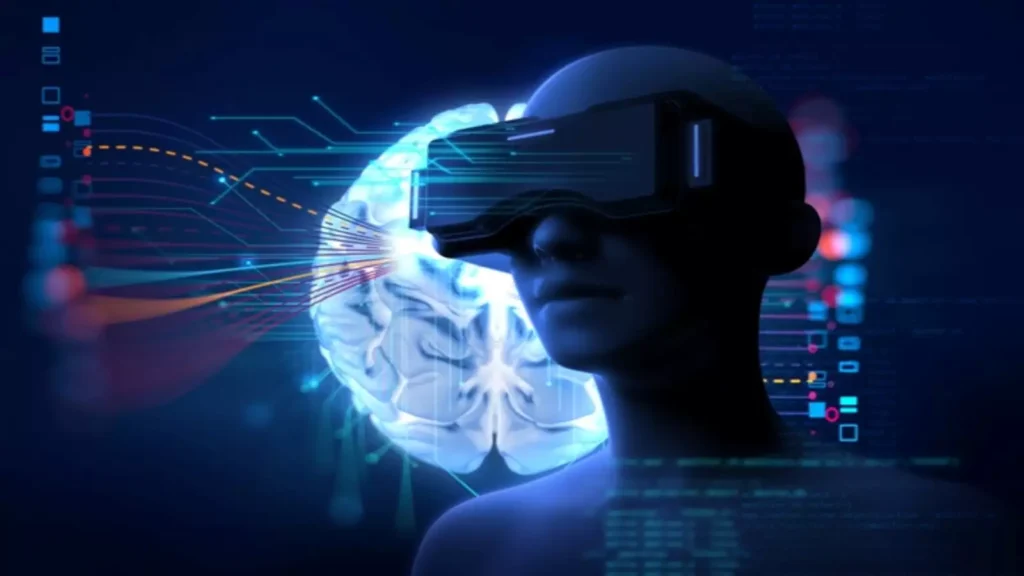
Virtual reality is no longer science fiction—it’s revolutionizing patient care, medical training, and therapy.
These cutting-edge healthcare app ideas immerse users in interactive 3D environments, from surgical simulations to pain-distraction worlds.
Why VR Healthcare Apps Are Game-Changers in 2025
- The medical VR market will reach $7.1B by 2028 (Grand View Research)
- VR reduces pain perception by 40% during wound care (NIH study)
- Surgeons trained in VR make 76% fewer errors (Harvard Medical School)
Types of VR Healthcare Apps
| Type | Key Features | Top Examples | Breakthrough Impact |
| Surgical Training | Haptic-feedback operations | Osso VR, Fundamental Surgery | Cuts learning time by 50% |
| Pain Management | Immersive distraction therapy | AppliedVR, SnowWorld | Reduces opioid use by 30% |
| Phobia Treatment | Gradual exposure therapy | Psious, OxfordVR | 80% success rate for arachnophobia |
| Patient Education | 3D organ/system explorations | BodyMap, HoloAnatomy | Improves treatment adherence 2x |
Must-Have Features for 2025
- Haptic Glove Integration – Realistic touch feedback for procedures
- Biometric Sync – Adjusts environments based on heart rate/stress
- Multiplayer Clinics – Collaborative VR doctor-patient consults
- Offline Modes – Critical for hospitals with spotty connectivity
Success Story: AppliedVR became the first FDA-approved VR pain therapy by:
- Clinically proving 42% pain reduction in chronic sufferers
- Partnering with 200+ hospitals, including Mayo Clinic
Development & Compliance Checklist
- FDA Class II Certification – Required for therapeutic claims
- Cybersickness Prevention – Frame rates must stay above 90fps
- HIPAA-Compliant Avatars – For patient privacy in training scenarios
Pro Tip:
“Add ‘Patient Journey’ VR experiences—letting doctors ‘walk in their shoes’ boosts empathy by 60%.” – Stanford Medicine Study
For Health App Development Companies:
- Use Unity/Unreal Engine for photorealistic graphics
- Target standalone headsets (Oculus Quest, PICO) for accessibility
- Develop web-based VR for low-cost access
- Exercise Apps
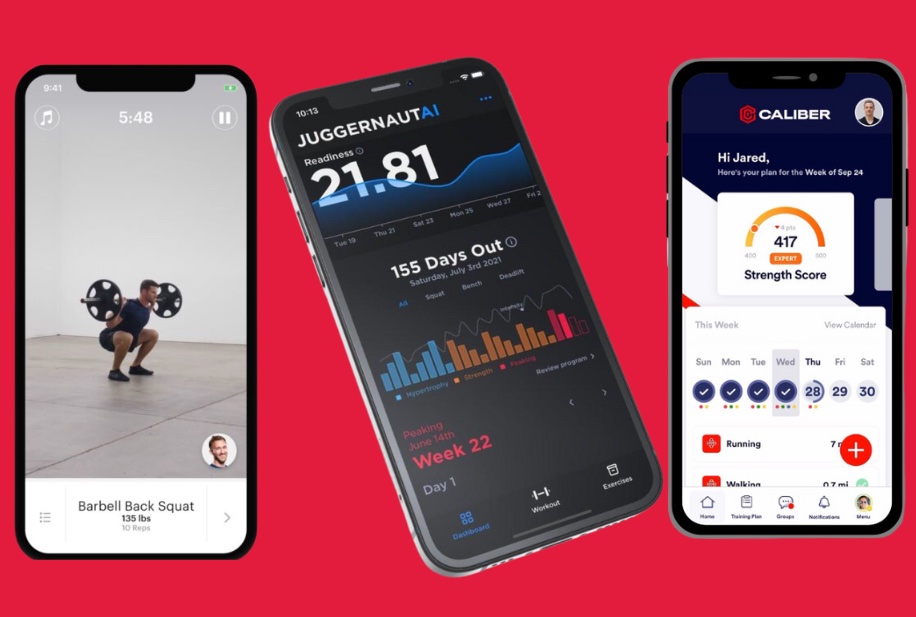
Today, exercise apps have become an indispensable tool in keeping fit, treating injuries, and maintaining well-being.
These healthcare app ideas apply AI, wearable technology, and personal coaching to make fitness reachable for everyone-from novices to elite athletes.
Why Exercise Apps Are Essential in 2025
- The global fitness app market will reach $30B+ by 2026 (Statista)
- 60% of users stick to workouts longer with app guidance (ACSM study)
- Integration with wearables and smart gym equipment creates a seamless fitness ecosystem
Types of Exercise Apps
| Type | Key Features | Top Examples | Unique Benefits |
| AI Personal Trainers | Custom workouts based on goals/abilities | Freeletics, Fitbod | Adapts to performance in real-time |
| Rehabilitation Guides | Post-injury/therapy exercise plans | RehabMyPatient, PhysiApp | Used by 40% of physical therapists |
| Community Fitness | Live classes + social challenges | Peloton, Zwift | Boosts motivation by 70% |
| Workplace Wellness | Corporate health programs | Virgin Pulse, Wellable | Reduces sick days by 25% |
Must-Have Features for 2025
- Motion Tracking – Uses phone camera/AI to correct form in real-time
- Recovery Analytics – Recommends rest days based on muscle strain
- Equipment-Free Modes – Effective workouts anywhere (hotel rooms, parks)
- Health Data Sync – Integrates with Apple Health/Google Fit
Success Story: Freeletics grew to 50M+ users by:
- Offering bodyweight-only programs during pandemic gym closures
- Adding AI form coaching that reduced injuries by 35%
Development & Compliance Considerations
- FDA Approval – Needed for apps claiming medical rehab benefits
- Wearable API Integration – Apple Watch, Garmin, Whoop
- Personalization Engines – Machine learning for adaptive workouts
Pro Tip:
“Users who receive ‘form feedback’ complete 3x more sessions—build this into your video analysis.” – Fitness Tech Report
For Health App Development Companies:
- Use TensorFlow Pose for real-time movement analysis
- Partner with physical therapists for medical credibility
- Implement adaptive bitrate streaming for rural users
- Health Monitoring Apps
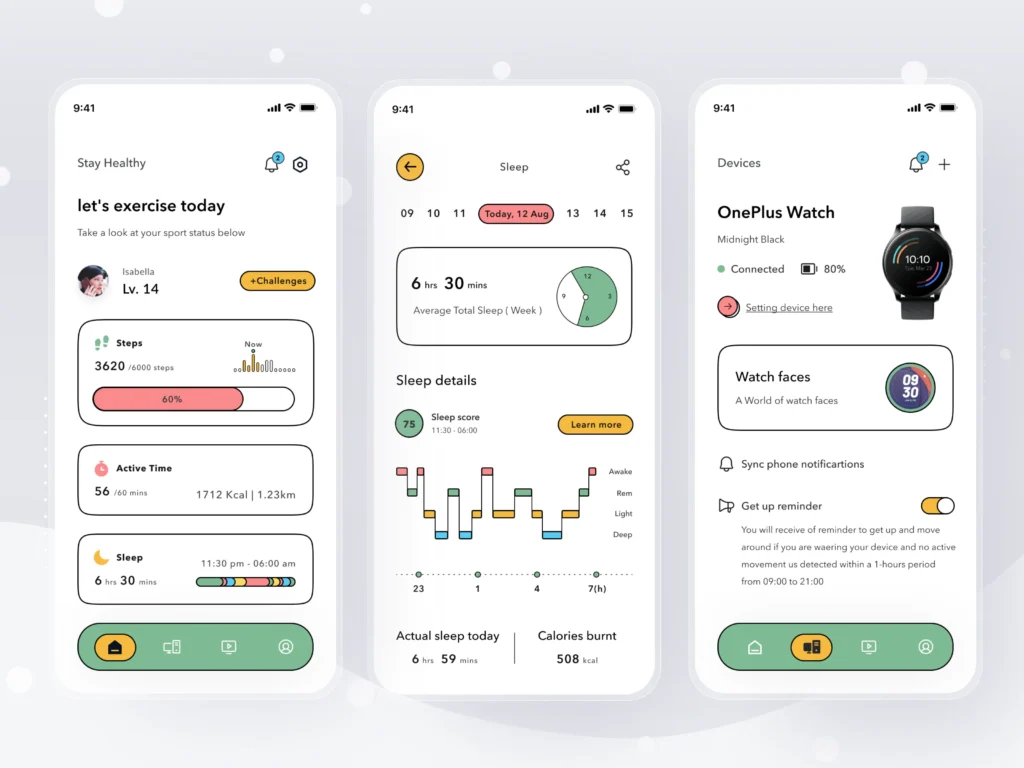
In an era where preventive healthcare is paramount, monitoring apps have emerged as essential tools for tracking vital signs, detecting early warning signs, and empowering users to take control of their well-being.
These healthcare app ideas combine wearable tech with AI analytics to provide real-time health insights.
Why Monitoring Apps Are Revolutionizing Healthcare in 2025
- 45% of adults now use health monitoring tech daily (Rock Health)
- Continuous monitoring reduces hospital readmissions by 38% (JAMA Study)
- The remote patient monitoring market will hit $175B by 2027 (Grand View Research)
Types of Health Monitoring Apps
| Category | Key Functionality | Top Examples | Life-Saving Impact |
| Chronic Condition Trackers | Real-time glucose/BP monitoring | Dexcom, Omada | Reduces ER visits by 42% |
| Elderly Safety Monitors | Fall detection + emergency alerts | Lively, CarePredict | Extends independent living by 3+ years |
| Post-Op Recovery Apps | Surgical site monitoring + alert system | Pillo, RecoveryRecord | Cuts complications by 35% |
| General Wellness Hubs | 24/7 heart rate/SpO2 tracking | Whoop, Oura Ring | Identifies sleep disorders early |
Must-Have Features for Next-Gen Monitoring Apps
- Multi-Wearable Sync – Seamless data flow from Apple Watch/Fitbit/medical devices
- Predictive Alerts – AI that spots anomalies before symptoms appear
- Caregiver Dashboards – Remote access for family/doctors
- Offline Functionality – Critical for areas with poor connectivity
Breakthrough Case Study: Dexcom’s glucose monitoring system:
- Reduced hypoglycemia events by 72% in diabetics
- Integrated with insulin pumps for automated treatment
- Became the first FDA-approved app for insulin dosing decisions
Development Essentials for Monitoring Apps
- Regulatory Compliance (FDA Class II for medical-grade monitoring)
- Military-Grade Encryption (PHI protection)
- Battery Optimization (Continuous background operation)
Pro Tip:
“Adding ‘Health Trend Reports’ that users can share with doctors increases clinical utility by 5x.” – Digital Health Developer Report
For Health App Development Companies:
- Use FHIR standards for EHR integration
- Implement adaptive sampling to preserve battery life
- Partner with clinicians to validate thresholds
- Healthcare Informational Apps
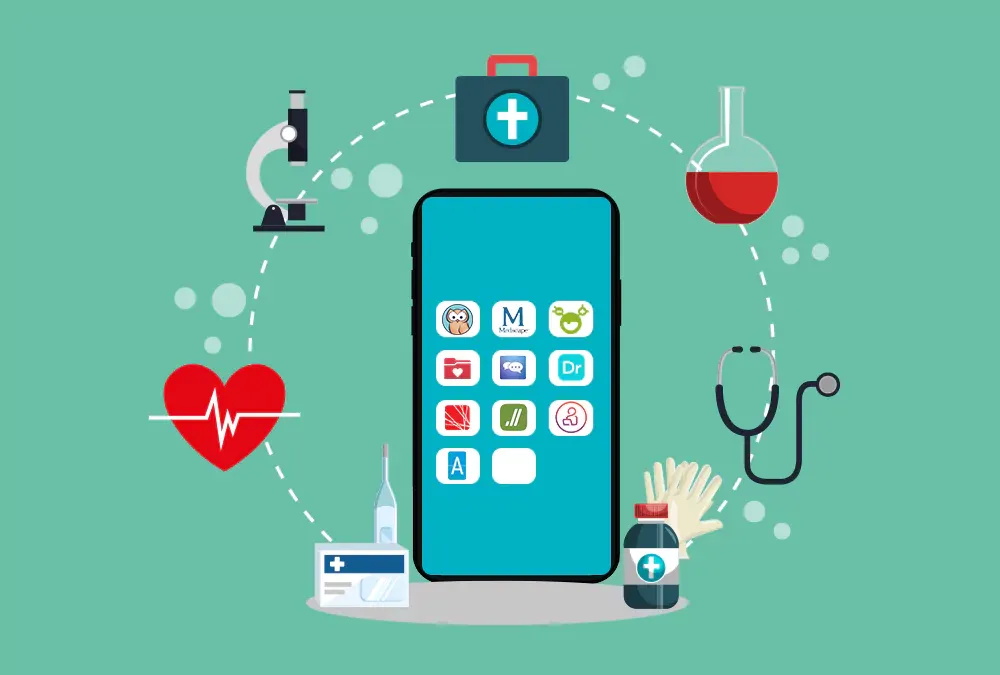
Healthcare informational apps give everyone expert health knowledge in seconds.
What makes them special:
- Turn complex medical terms into plain English
- Provide 24/7 access to drug guides, symptom checkers, and treatment info
- Are vetted by doctors, but designed for regular people
How they help you:
→ Students study smarter with 3D anatomy models
→ Parents check symptoms before calling the doctor
→ Seniors verify medications with pill identifiers
Best part? They fit in your pocket but contain more knowledge than most clinic libraries.
Types of Health Informational Apps
| App Type | Best For | Top Examples | Why It Works |
| Clinical Reference | Doctors & nurses | UpToDate, DynaMed | Provides the latest treatment guidelines |
| Patient Education | General public | K Health, Drugs.com | Explains conditions in simple terms |
| Medical News | Healthcare pros | Medscape, Figure1 | Curating breaking medical research |
| Q&A Platforms | Quick advice | HealthTap, Lybrate | Connects users with doctors online |
Features Users Love
- Pill Identifier – Snap a photo to learn about medications
- Symptom Checker – Understand possible causes of symptoms
- Offline Access – Critical for areas with poor internet
For Developers: Focus on accurate sources and simple design. Even complex medical info should feel approachable.
- Eldercare Apps
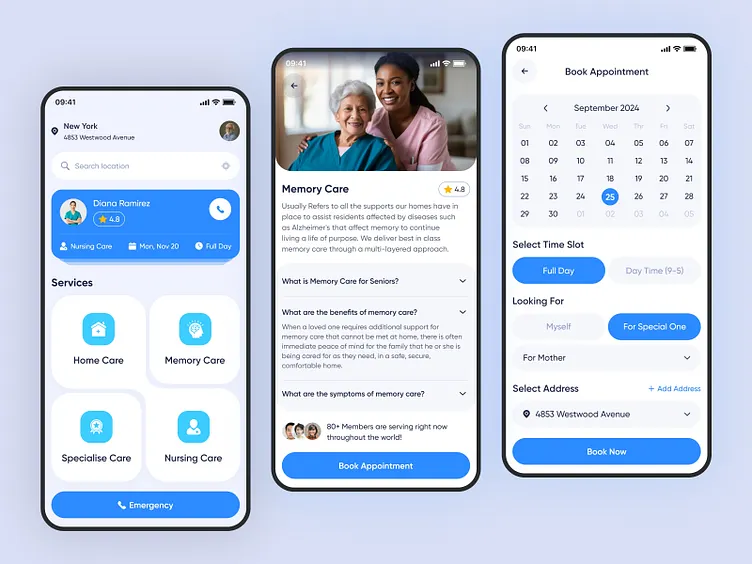
Eldercare apps don’t just remind seniors to take pills – they’re lifelines that help aging adults maintain independence while giving families peace of mind.
Why They’re Essential
- 70% of seniors will need long-term care
- Family caregivers save 3+ hours weekly using these tools
- Fall detection tech reduces hospitalizations by 45%
Key Features That Matter
| Need | App Solution | Real-World Example |
| Medication Safety | Smart dispensers with family alerts | Pillo (voice-controlled) |
| Emergency Response | One-tap SOS + GPS | Lively Mobile |
| Cognitive Support | Memory games + routine guides | MindMate |
| Social Connection | Simplified video calling | GrandPad |
Success Story: CarePredict uses AI to spot health declines 2 weeks earlier by analyzing daily activity patterns.
For Developers
✓ Large touch targets (for arthritic hands)
✓ Voice-first interfaces (vision-friendly)
✓ Family dashboards (shared access)
“The best eldercare tech feels like helpful grandkids – not hospital equipment.”
- Childcare Apps
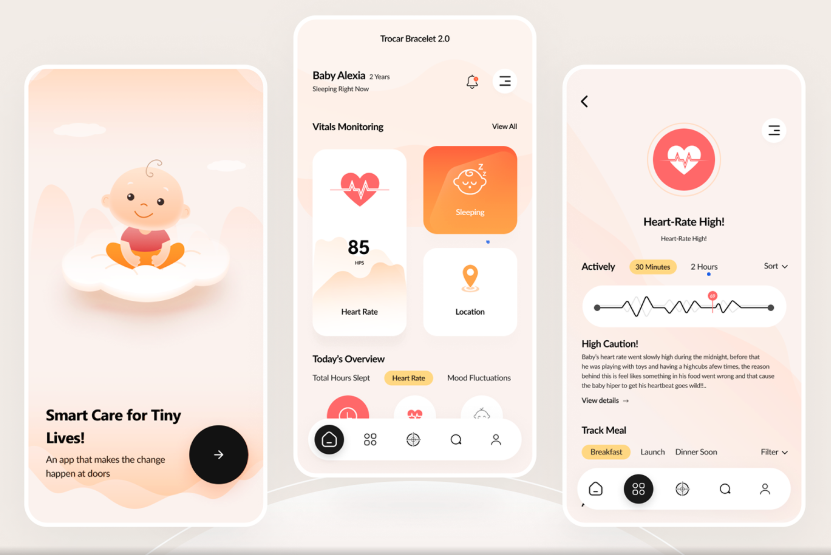
Childcare apps do more than track feedings – they’re like having a pediatric nurse, nutritionist, and parenting coach in your pocket.
Why Modern Parents Rely on Them
- 83% of new parents use at least 2 childcare apps
- Reduces unnecessary pediatric visits by 35%
- Vaccination trackers improve schedule compliance by 60%
Must-Have Features for 2025
| Parenting Challenge | App Solution | Top Performer |
| Sleep Training | Smart sound machines + pattern analysis | Huckleberry |
| Feeding Logs | Nursing timer/formula tracker | Baby Tracker |
| Developmental Milestones | Interactive checklists + expert tips | The Wonder Weeks |
| Emergency Preparedness | Instant video chat with pediatricians | Blueberry Pediatrics |
Tech That Wows Parents:
- AI cry translation (predicts needs from the baby’s sounds)
- Augmented reality to visualize growth metrics
- Smart bottle warmers with app-controlled temperature
For Developers:
✓ Dual profiles (for divorced/co-parenting families)
✓ Offline functionality (for nighttime feedings)
✓ HIPAA-compliant messaging for doctor consults
“The best childcare apps don’t just log data – they read between the lines of parenting stress.”
- Hospitals Apps
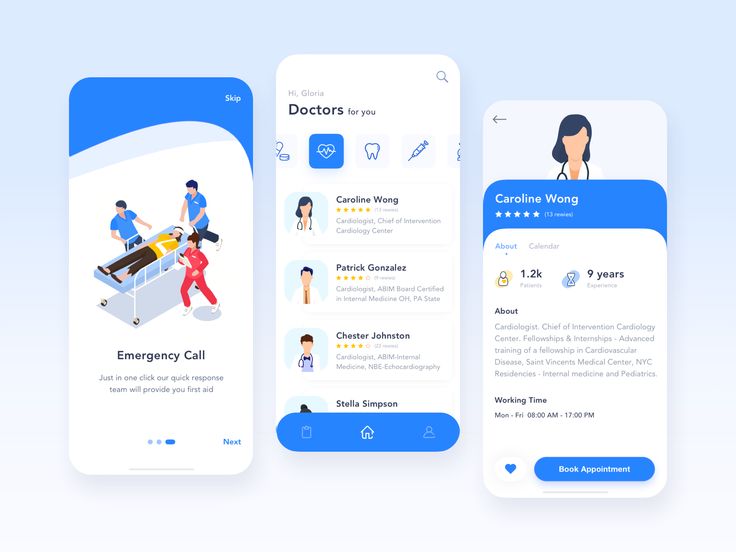
Hospital apps are changing the health experience, enabling care to be more efficient for providers and more empowering for patients. Here are some of the ways they’re doing it.
- For patients: Easier to book an appointment, access to test results, personalized plan of care
- For doctors: Access to records in an instant, AI-supported diagnosis, and agreed workflows and processes
- For hospitals: Resource allocation (time, human, supplies), management of human system burdens, and improved outcomes
Key Areas of Transformation:
✔ Patient Engagement: Digital check-ins and telehealth options reduce wait times
✔ Clinical Efficiency: e-Prescribing and decision support tools minimize errors
✔ Operational Excellence: Smart scheduling and inventory tracking maximize resources
The result? A healthcare system that works better for everyone involved.
Essential Hospital App Categories
| Department | App Functionality | Industry Leader | Impact |
| Patient Management | Digital registration, bed tracking | Epic MyChart | Saves 8+ hours weekly for staff |
| Clinical Decision Support | Real-time treatment guidelines | UpToDate | Reduces diagnostic errors by 30% |
| OR Coordination | Surgery scheduling, inventory tracking | ReadySet | Cuts case delays by 25% |
| Remote Monitoring | Post-op recovery tracking | GetWell Loop | Lowers readmissions by 18% |
2025 Game-Changing Features
- AI Triage Bots that prioritize emergency cases
- Augmented Reality for vein finding/blood draws
- Blockchain-Based Medical Record Sharing
- Predictive Analytics for ICU Bed Management
Success Story:
Cleveland Clinic’s app reduced no-show rates by 22% through:
- Automated appointment reminders
- Wayfinding beacons for hospital navigation
- Pre-check-in via smartphone
Development Considerations
✓ Integration with major EHR systems (Epic, Cerner)
✓ Role-Based Access for staff/patients/families
✓ Disaster Recovery protocols for critical care functions
“The best hospital apps work like air traffic control – coordinating every moving part while keeping patients at the center.”
- Health Condition Checker Apps
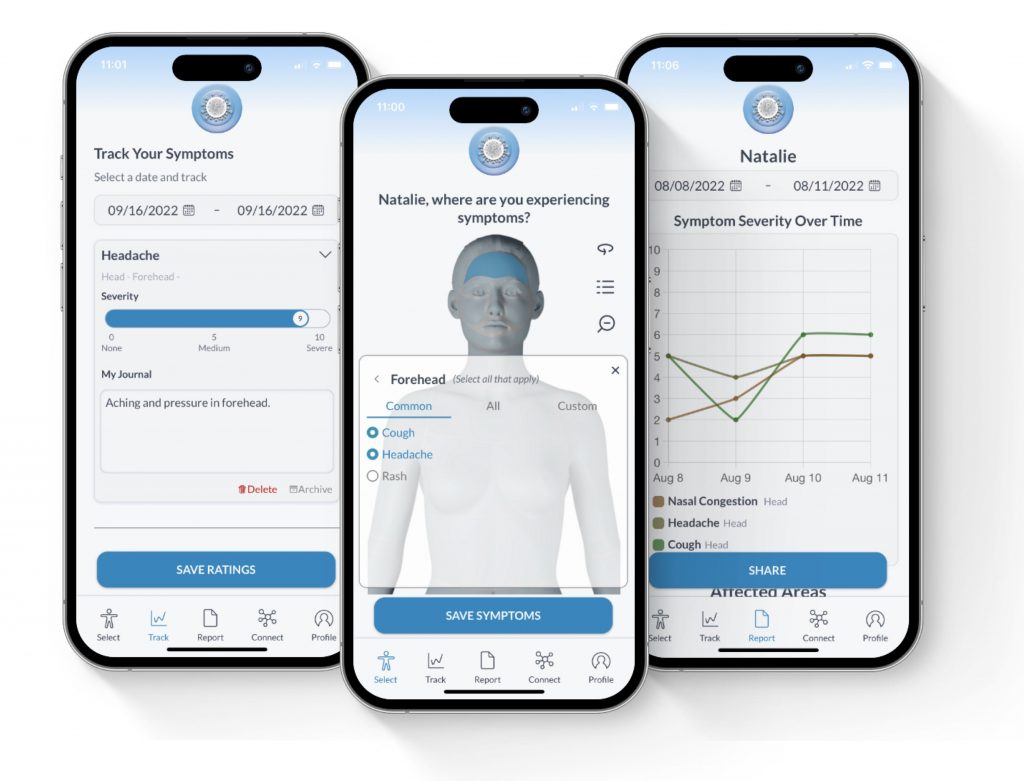
These apps go beyond WebMD searches – they combine AI analysis with medical expertise to help users understand symptoms while avoiding unnecessary panic.
Why They’re Becoming Essential
- 65% of patients research symptoms online before seeing doctors
- AI-powered checkers now match nurse triage accuracy in 80% of cases
- Reduce unnecessary ER visits by 40% through proper guidance
How Modern Checker Apps Work
| User Input | AI Analysis | Output | Example App |
| Symptom logging | Cross-references 5M+ case studies | Likely condition list | Ada Health |
| Photo upload (rash, eye, etc.) | Computer vision diagnosis | Visual match analysis | SkinVision |
| Voice description (cough, breathing) | Audio pattern recognition | Respiratory assessment | ResApp |
| Wearable data sync (heart rate, temp) | Trend analysis | Early warning alerts | K Health |
What Sets 2025’s Apps Apart:
- Multimodal input (type, speak, or show symptoms)
- Personalized risk scoring (considers your medical history)
- Care pathway guidance (“Monitor at home” vs “See doctor now”)
For Developers:
✓ Clinical validation (partner with teaching hospitals)
✓ Safe disclaimer design (“This is not a diagnosis”)
✓ Escalation protocols (direct links to telemedicine)
“The best symptom tools don’t just list possibilities – they reduce anxiety through clear next steps.”
- Disease Management Apps
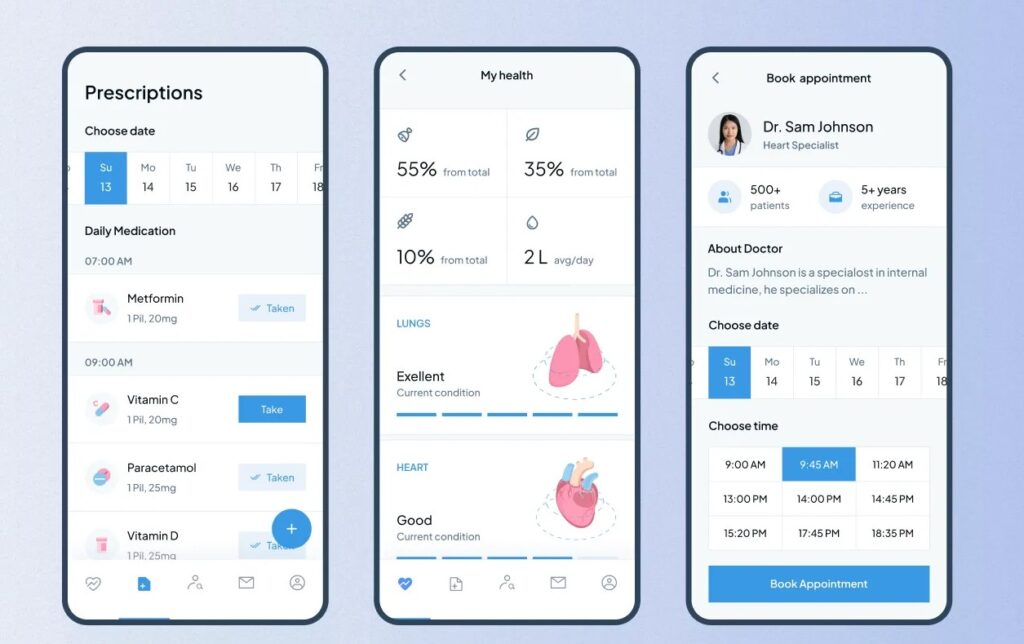
These apps do more than track symptoms – they become 24/7 health allies for people living with diabetes, hypertension, COPD, and other chronic conditions.
Why They’re Life-Changing
- Patients using these apps show 38% better medication adherence
- Reduce hospitalizations by up to 50% for chronic conditions
- Save users $1,300+/year in avoided complications
Top Disease-Specific Solutions
| Condition | App Superpowers | Leading App | Proven Results |
| Diabetes | Continuous glucose monitoring + AI meal planning | mySugr | 1.2% A1C reduction |
| Hypertension | Smart BP tracking + medication reminders | Blood Pressure Companion | 30% more controlled readings |
| COPD | Breathing exercises + flare-up alerts | MyCOPD | 41% fewer ER visits |
| Mental Health | Mood tracking + crisis prevention tools | Bearable | 60% lower relapse rates |
2025’s Breakthrough Features
- Predictive Alerts (spots flares 3 days before symptoms)
- Automated Clinician Updates (shares data with care teams)
- Voice-Activated Logging (“Alexa, log my morning blood sugar”)
- Community Support (connects patients with similar journeys)
Success Story:
Omada Health reduced diabetes risk by 30% through:
- Digital coaching programs
- Smart scale integration
- Health insurer partnerships
For Developers Building These Apps
✓ FDA Clearance is required for treatment suggestions
✓ Interoperability with major EHR systems
✓ Accessibility for elderly/disabled users
“The best disease apps feel like having a nurse in your pocket – they don’t just collect data, they truly care for you.”
Read Also: How Much Does Hybrid App Development Cost in 2025
Conclusion
The healthcare app revolution has arrived, and it is changing people’s lives. From mental health to chronic disease, these digital tools are making healthcare more accessible, personalized, and efficient than it has ever been before.
What You Should Know in 2025:
- Patients Win – Faster diagnosis, 24/7 support, and fewer unnecessary hospital visits.
- Doctors Benefit – Streamlined workflows, AI-assisted decisions, and better patient monitoring.
- Startups Have Opportunity – The global digital health market will surpass $500B by 2027, with apps leading the charge.
Before You Build:
- Validate demand – Solve real problems, not hypothetical ones.
- Prioritize compliance – HIPAA, GDPR, and FDA approvals can’t be afterthoughts.
- Design for humans – The best healthcare apps feel like caring partners, not cold tech tools.
The Future? Apps that predict illnesses before symptoms appear, automate treatment adjustments, and connect global experts instantly.
Your Next Steps:
- Pick one idea that excites you most
- Partner with doctors for clinical validation
- Start small – Even basic MVP apps save lives
“The best healthcare apps don’t just track vitals—they give people back their freedom, confidence, and quality of life.“
Which app idea will you bring to life? The next breakthrough could be yours.
(Need help choosing or developing your concept? Let’s discuss!)
FAQs
- What’s trending in healthcare apps right now?
Trends for 2025 are being set by AI symptom checkers, integrations for chronic care with wearables, and health logs that are voice-driven, but one of the areas with the most growth is the app market for mental health and the care of seniors.
- Which compliance standards matter most?
Compliance for HIPAA in the US, GDPR in the EU, as well as FDA Class II compliance for diagnostic apps, are all important compliance methods, as well as any other location-specific to where the app is being deployed, such as PIPEDA in Canada.
- How long does development typically take?
- MVP: 3-6 months
- Full-featured app: 9-18 months
(Factors: features, integrations, and testing rigor)
- What’s the biggest mistake to avoid?
Skipping clinician validation – even well-designed apps fail without medical expert input.
- Can apps replace doctors?
No. Apps are not meant to replace doctors, only to assist with awareness and monitoring, and improve access to care – they are not meant as substitute diagnostic tools.




